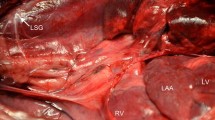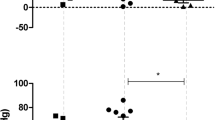Summary
The efferent activity of the vertebral, cardiac and renal sympathetic nerves was recorded during the so-called “early vasospasm” period, 25–30 minutes after experimentally induced subarachnoid haemorrhage. Experiments were performed on 51 cats with methods described in Part I of our publication. The animals were held either in a sphynx-like position (Pos. I), or in head-down position (Pos. II), when the level of the cisterna magna was 2–3 cm below the level of the spinal cord, facilitating the injected blood to flow in to, and remain at the base of the brain. According to our results during the “early vasospasm” period, we could not observe such changes in the sympathetic efferent activity, which could be specific for this period. With the gradual decrease in the intracranial pressure, the sympathetic overactivity ceased, and in most cases the level of activity was similar to that of the preinjection period. Our results also indicate that because of the remarkable variability of the activity of the renal sympathetic nerve during the intracranial pressure elevation, recording the activity of one sympathetic nerve only may give misleading results concerning the activity of the whole sympathetic system.
Similar content being viewed by others
References
Allen, G. S., Gold, L. H. A., Chou, S. N., French, L. A., Cerebral arterial spasm. Part 3: In vivo intracisternal production of spasm by serotonin and blood and its reversal by phenoxybenzamine. J. Neurosurg.40 (1974), 451–458.
Arutiunov, A. I., Baron, M. A., Majorova, N. A., The role of mechanical factors in the pathogenesis of short term and prolonged spasm of the cerebral arteries. J. Neurosurg.40 (1974), 459–472.
Echlin, F., Experimental vasospasm, acute and chronic, due to blood in the subarachnoid space. J. Neurosurg.35 (1971), 646–656.
Liszczak, T. M., Varsos, V. G., Black, P. Mc. L., Kistler, J. Ph., Zervas, N. T., Cerebral arterial constriction after experimental subarachnoidal hemorrhage is associated with blood components within the arterial wall. J. Neurosurg.58 (1983), 18–26.
Nagai, H., Noda, S., Mabe, H., Experimental cerebral vasospasm. Part 2. Effects of vasoactive drugs and sympathectomy on early and late spasm. J. Neurosurg.42 (1975), 420–428.
Nagai, H., Suzuki, Y., Sugiura, M., Noda, S., Mabe, H., Experimental cerebral vasospasm. Part 1. Factors contributing to early spasm. J. Neurosurg.41 (1974), 285–292.
Pásztor, A., Pásztor, E., Spinal vasomotor reflex and Cushing response. Acta Neurochir. (Wien)52 (1980), 85–97.
Rosner, M. J., Newsome, H. H., Becker, D. P., Mechanical brain injury: the sympathoadrenal response. J. Neurosurg.61 (1984), 76–86.
Sasaki, T., Wakai, S., Asano, T., Takakura, K., Sano, K., Prevention of cerebral vasospasm after SAH with a thromboxane synthetase inhibitor, OKY-1581. J. Neurosurg.57 (1982), 74–82.
Smigiel, M. R., Jr., Sundt, T. M., Jr., Comparative effectiveness of alpha blockade and beta stimulation in modifying experimental basilar arterial spasm. J. Neurosurg.41 (1974), 300–305.
Steiner, L., Löfgren, J., Zwetnow, N. N., Characteristics and limits of tolerance in repeated subarachnoid hemorrhage in dogs. Acta Neurol. Scand.52 (1975), 241–267.
Steiner, L., Löfgren, J., Zwetnow, N. N., Lethal mechanism in repeated subarachnoid hemorrhage in dogs. Acta Neurol. Scand.52 (1975), 268–293.
Umansky, F., Kaspi, T., Shalit, M. N., Regional cerebral blood flow in the acute stage of experimentally induced subarachnoid hemorrhage. J. Neurosurg.58 (1983), 210–216.
Varsos, V. G., Lszczak, T. M., Han, J. H.,et al., Delayed cerebral vasospasm is not reversible by aminophylline, nifedipine or papaverine in a “two hemorrhage” canine model. J. Neurosurg.58 (1983), 11–17.
White, R. P., Hagen, A. A., Morgan, H., Dawson, W. N., Robertson, J. T., Experimental study on the genesis of cerebral vasospasm. Stroke6 (1975), 52–57.
Wilson, J. L., Feild, J. R., The production of intracranial vascular spasm by hypothalamic extract. J. Neurosurg.40 (1974), 473–479.
Zervas, N. T., Hori, H., Rosoff, C. B., Experimental inhibition of serotonin by antibiotic: Prevention of cerebral vasospasm. J. Neurosurg.41 (1974), 59–62.
Author information
Authors and Affiliations
Additional information
This work was supported partly by the Hungarian Medical Research Council.
Rights and permissions
About this article
Cite this article
Fedina, L., Pásztor, E., Kocsis, B. et al. Activity of peripheral sympathetic efferent nerves in experimental subarachnoid haemorrhage. Acta neurochir 80, 42–46 (1986). https://doi.org/10.1007/BF01809556
Issue Date:
DOI: https://doi.org/10.1007/BF01809556




